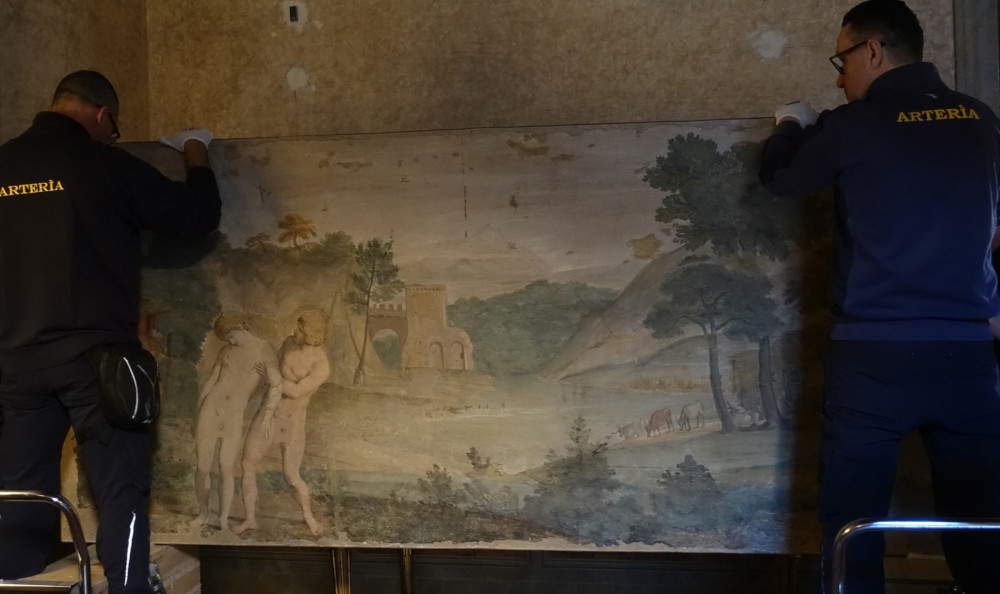Domenichino ’sApollo and Hyacinthus leaves Palazzo Farnese in Rome, home of theFrench Embassy, for a few months to be restored by theCentral Institute for Restoration, thus moving to Santa Marta al Collegio Romano, the Institute’s laboratory. A temporary move to restore original beauty to this painting by Domenico Zampieri, known as Domenichino (Bologna 1581- Naples 1641), the third in a series currently located in the Signature Hall of the French Embassy in Italy. Among the first independent works by the artist, who had been called to Rome in 1602 by his great master Annibale Carracci, Apollo and Hyacinthus is one of three frescoes painted to decorate the vaults of the loggia of the so-called Casino della Morte, a small building commissioned by Cardinal Odoardo Farnese as an intimate and cozy annex to the grandiose family palace. Situated on the bank of the Tiber, and so named because of its contiguity with the church of Santa Maria dell’Orazione e Morte, the Casino opened on the first floor onto a lush garden overlooking the river and was accessible directly from the main palace through the archway that still bypasses Via Giulia. All three paintings (the others are The Death of Adonis and Narcissus Reflecting in the Water) were detached in 1817 by restorer Pietro Palmaroli.
Executed by the Bolognese painter between 1603 and 1604, the frescoes depict three characters from Greek mythology whose violent deaths prelude a plant metamorphosis and the birth of a new flower. The Death of Adonis was depicted on the vault of the portico overlooking the gardens toward the river, Apollo and Hyacinthus on the vault of the room on the right while Narcissus, painted last in late 1603, decorated the vault of the room on the left.
The detached mural painting, Apollo and Hyacinthus, has therefore been taken over by theICR for restoration as part of the ongoing collaboration with the French Embassy, in agreement with the Soprintendenza Speciale Archeologia, Belle Arti e Paesaggio of Rome. It will undergo a preliminary study of its state of preservation and the outcomes of the previous interventions it has undergone, through visual observations and macro and microscopic photographic shots, multispectral surveys and micro-samples for chemical and mineralogical analysis. The results of this cognitive campaign will guide the operational protocols of the interventions that will be put in place for the conservation recovery of the work, through phases of cleaning, reestablishment of adhesion and cohesion of the pictorial film and preparatory layers, revision of the support, filling of gaps and final aesthetic presentation.
Ambassador Christian Masset wanted to emphasize how important “the cooperation of the two institutions with this Embassy is for the remarkable restoration work of Domenichino’s works, a pillar admired throughout the world of seventeenth-century Bolognese painting,” and how “the protection of our heritage is an issue on which France and Italy work hand in hand.”
ICR Director Alessandra Marino explains that “it is a great satisfaction for us, thanks to the fruitful and well-established collaboration with the French Embassy, to take care of the third and last detached fresco by Domenichino in his youthful activity. The ICR, which is fully funding the restoration, will study the work in light of the two works already carried out, and will conduct the operations at the laboratory of Santa Marta at the Collegio Romano. We are happy to announce that the week after Easter our third location, located in the heart of the historic center, will finally be able to reopen its doors to the public of schools, scholars and those who wish to book a guided tour.”
In 2019, on the occasion of Narciso’s return to Palazzo Farnese, a meeting had been organized around the relationship between restoration, research and museums in France and Italy, which made an important contribution to research in the field.
The many cultural activities around the restoration of the side facades and roof of Palazzo Farnese, home of the French Embassy, launched last year, will continue. Work is also underway to repair the terracotta tiles on the main floor of Palazzo Farnese. Thus, the manufacturer’s stamp and the date of manufacture was found on the tiles’ bedding: 1845, which corresponds to the period of restoration of the palace under the direction of architect Cipolla. While on April 14, conservation work will begin to return the Monumental Fireplace and the two statues flanking it, representing the virtues of Abundance and Charity, present in the Hall of Hercules, to their former glory, thanks to Palazzetti Spa and Fondaco Italia.
 |
| Temporary move for Domenichino's Apollo and Hyacinthus: will be restored by ICR |
Warning: the translation into English of the original Italian article was created using automatic tools. We undertake to review all articles, but we do not guarantee the total absence of inaccuracies in the translation due to the program. You can find the original by clicking on the ITA button. If you find any mistake,please contact us.